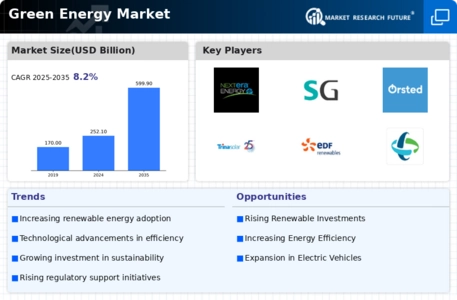The The Green Energy Market is currently characterized by a dynamic competitive landscape, driven by increasing global demand for sustainable energy solutions and regulatory support for renewable technologies. is currently characterized by a dynamic competitive landscape, driven by increasing global demand for sustainable energy solutions and regulatory support for renewable technologies. Key players such as NextEra Energy (US), Iberdrola (ES), and Orsted (DK) are strategically positioned to leverage their extensive portfolios in wind, solar, and other renewable sources. NextEra Energy (US) focuses on innovation and expansion, particularly in solar and battery storage technologies, while Iberdrola (ES) emphasizes its commitment to offshore wind projects, enhancing its market share in Europe and beyond. Orsted (DK), a leader in offshore wind, continues to invest heavily in new projects, indicating a robust operational focus on expanding its renewable energy capacity. Collectively, these strategies not only enhance their competitive positioning but also contribute to a rapidly evolving market landscape where sustainability is paramount.
In terms of business tactics, companies are increasingly localizing manufacturing and optimizing supply chains to enhance efficiency and reduce costs. The Green Energy Market appears moderately fragmented, with a mix of large multinational corporations and smaller, innovative firms. The collective influence of key players is significant, as they drive technological advancements and set industry standards, thereby shaping the competitive structure of the market.
In August 2025, NextEra Energy (US) announced a major investment in a new solar farm in Texas, which is expected to generate over 1,000 megawatts of clean energy. This strategic move not only reinforces its leadership in solar energy but also aligns with the growing demand for renewable sources in the U.S. market. The investment is likely to enhance NextEra's operational capacity and solidify its position as a frontrunner in the transition to sustainable energy.
In September 2025, Iberdrola (ES) unveiled plans to develop a new offshore wind farm off the coast of Scotland, aiming to produce 3,000 megawatts of energy by 2030. This initiative underscores Iberdrola's commitment to expanding its renewable energy footprint and capitalizing on the increasing demand for offshore wind solutions. The strategic importance of this project lies in its potential to significantly contribute to the UK’s renewable energy targets, thereby enhancing Iberdrola's competitive edge in the European market.
In July 2025, Orsted (DK) completed the acquisition of a portfolio of solar projects in the United States, further diversifying its renewable energy offerings. This acquisition is strategically important as it allows Orsted to expand its presence in the solar market, complementing its existing offshore wind operations. The integration of solar energy into its portfolio may provide Orsted with a competitive advantage as the market increasingly shifts towards a more diversified energy mix.
As of October 2025, current competitive trends in the Green Energy Market are heavily influenced by digitalization, sustainability initiatives, and the integration of artificial intelligence in energy management systems. Strategic alliances among key players are shaping the landscape, fostering innovation and collaboration in technology development. Looking ahead, competitive differentiation is likely to evolve from traditional price-based competition to a focus on innovation, technological advancements, and supply chain reliability, as companies strive to meet the growing expectations of consumers and regulators alike.























Leave a Comment